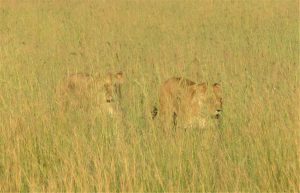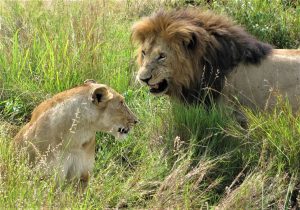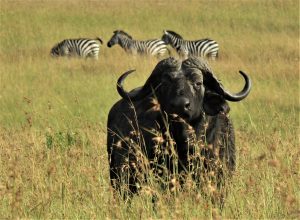“The animals are used to the vehicles. They don’t see them as food,” our guides told us as we set out on our first safari drive, “but the minute you step out, you are prey.”

After seeing the effective camouflage that the tall yellow grass provided for the golden lions, you can believe that I never disobeyed that Number One Rule: “Never exit the pop-top Land Cruiser without permission!”

But what, I wondered, were the rest of the rules for staying safe? What about our snack stops when we were allowed to wander a bit? We may not be able to see the lions through the grass, but I was pretty sure they could see us! There must be more we need to know.
There was! Every evening, as the sun set over the wide plains of the Serengeti, our little group gathered around an open pit fire to share our memories of the day and listen to our guide, Cosmas, entertain us with stories of his life in Tanzania. On our very last night of our stay in our rustic tent camp, Cosmas decided it was finally time to tell us how to stay safe around the African animals. Now, why he waited until our last night in the bush instead of our first, I cannot say, but I was relieved to finally get Rules #2 through #5.
“Lions love the chase,” Cosmas told us. “If you do happen to stumble across a lion in the bush, back slowly away. Do NOT turn your back on him and NEVER EVER run.”
 Unfortunately, I did not include in my notes exactly how far to back up before running shrieking into the distance or collapsing into a quivering fetal position, so you may have to experiment. Cosmas also did not say whether or not it helps to say in a sweet, soothing voice, “Nice kitty! Stay there, kitty!” as you are backing up, but I’m guessing that silence is preferable.
Unfortunately, I did not include in my notes exactly how far to back up before running shrieking into the distance or collapsing into a quivering fetal position, so you may have to experiment. Cosmas also did not say whether or not it helps to say in a sweet, soothing voice, “Nice kitty! Stay there, kitty!” as you are backing up, but I’m guessing that silence is preferable.
It seems rather obvious that, with their great noses, elephants have a superior sense of smell. The trick to being safe when you encounter elephants is to stay upwind. If they do catch a whiff of you and charge, don’t run in a straight line. Run in a zig-zag pattern. Their immense size hampers their ability to make quick direction changes.

The Cape buffalo may look like a big cow as it grazes its way across the grasslands, but those massive horns are not just for show. The best strategy for surviving a Cape buffalo attack, Cosmas assured us, is to “lie down and act dead.” If you are still enough, they may just ignore you. And if they still find you to be a threat, then lying down makes it harder for those sharp curved horns to gore you into little pieces. 
Hyenas are one of Africa’s scavengers, so they require the opposite strategy. The trick with them is to “act alive.” Although they may look like cuddly round-ears dogs, these creatures could tear you apart with their powerful jaws. Happily, they’d rather take the easy route to a meal by snacking on a carcass not finished off by the lions or cheetahs. So when you encounter a hyena, dance a jig, sing a song, wave your arms, and the hyena may think you are so crazy that he’ll just run in the opposite direction.


“Unfortunately,” added Cosmas, “if you come across a Cape buffalo and a hyena at the same moment, there is no plan for that!”
What a comfort to know that when I return to Africa, I will remain safe in the presence of lions, elephants, Cape buffaloes, and hyenas. Now I just need to study up on the rules for escaping from the other most dangerous animals in Africa – the hippo, black mamba, Nile crocodile – and the deadliest of all, the malarial mosquito!

